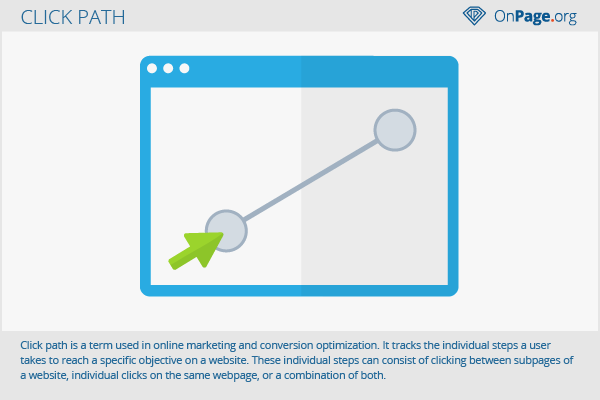Click Path
Click path is a term used in online marketing and conversion optimization. It tracks the individual steps a user takes to reach a specific objective on a website. These individual steps can consist of clicking between subpages of a website, individual clicks on the same webpage, or a combination of both.
Structure
A click path is usually composed of the path along which a user travels from entering the page to the exiting it. However, click paths within a webpage can be considered as well in order to draw the necessary conclusions for optimization. The source of the entry page, the bounce rate on the homepage, the length of stay per page, and the number of pages that a visitor views are often important in analyzing click paths. Length of stay and bounce rate are taken into account by Google as part of ranking.
Example based on an online store
As a website visitor, you use Google search to get to an info page (also called landing page). From there you click on a category overview, then to a detail page, where you put a product into your cart. Thus, a percentage of sales can be assigned to each page on the click path and through web analytics, all entry pages can be allocated online marketing measures proportionately. The length of the click path can thus be measured as a KPI in e-commerce. If an online store knows the average length of the click path that leads to a conversion within a given category, the whole architecture of the page can be optimized.
Online stores strive for short click paths to the purchase of a product. In portals or news pages from publishers, however, long click-paths are considered desirable, since conversions can be increased by more frequent advertising.
The click path to the shopping cart
Shopping cart optimization plays a major role especially in conversion optimization. Again, it is the click path which is analyzed. The faster a customer goes through the ordering process, the more likely it is that he also buys something. Accordingly, all elements that lead to bouncing off the click path required for a purchase must be minimized or optimized. Optimization can include adding trust elements such as shopping seals or customer opinions, or can be achieved by adapting graphical elements. One-page checkouts, where customers complete the entire ordering process on only one page are another common alternative.
Click paths and event tracking
A click path doesn’t only consist of separately accessed URLs for each step. Event tracking allows you to establish the click paths for individual clicks on page elements. In an online store, this could be clicks on more information about the product range or a long description.
Importance for search engines
The length of a click path can be an indicator of the relevance or legitimacy of a website for search engines. The longer a click path, the more information appears to be provided by the applicable website. However, a page hierarchy that contains too many layers would be disadvantageous to users and search engines alike. A page depth of a maximum of four levels is recommended. This means that you have to click no more than four times to reach the desired page. Online stores usually circumvent this problem of too long click paths with efficient product search filters that guide you to the desired destination on a single page.
Web Links

